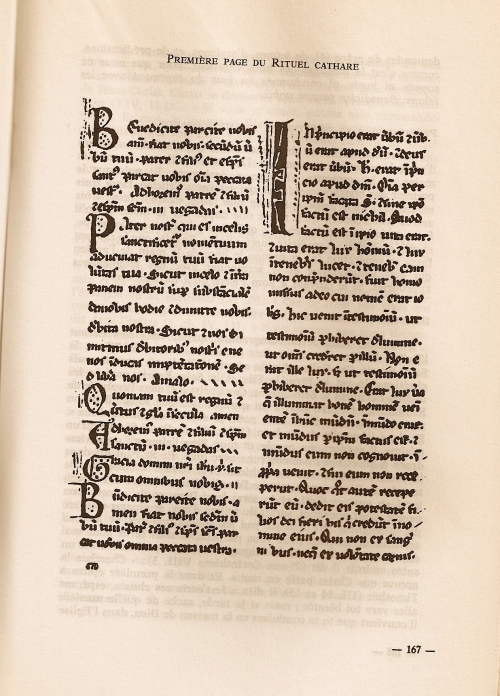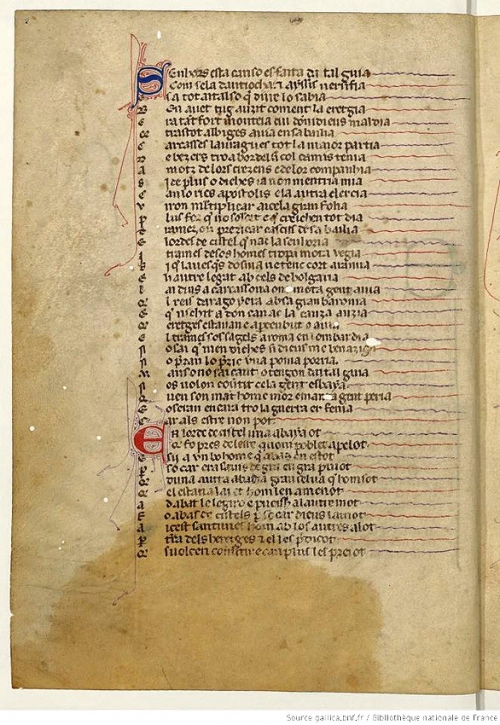Understanding Manuscripts
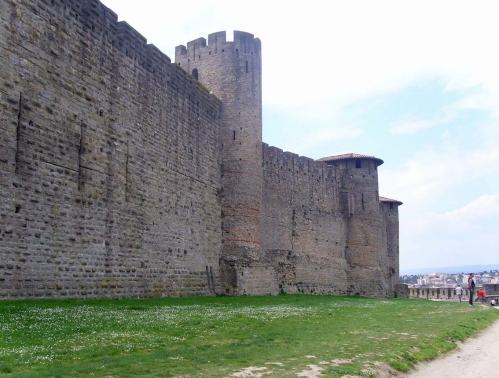
Just recently I posted on Facebook this short film of beautiful images of Occitania with music by Christian Salès on Facebook, haunting and beautiful.
A discussion ensued about the Occitan language. I explained that the Occitan language is a direct descendant of Latin - the Latin spoken by the Romans 2000 years ago in Languedoc, the language Mary Magdalene and Jesus would have heard spoken, for they lived in the Roman Empire. The Cathar and other medieval documents in Languedoc were written in Occitan, descended from Latin.
But we have our resident language expert here on our site! I asked Luigi for more details.
For a long period there was a great difference between written language (Latin) and spoken one. A Council of Tours in 813 decided that priests should preach sermons in the "rusticam romanam linguam aut teutiscam" (romance language or German) understood by the people, instead of the classical Latin the the ordinary people could no longer understand. It is commonly considered as the death of Latin as a live language and the birth of "Vulgar" languages. We have a very important document showing this dated a.D. 842: the oaths of Strasbourg (linguists can click here for more info) where, just in the beginning we have for the French "Pro Deo amur et pro christian poblo et nostro commun saluament..." and for the Germans "In godes minna ind in thes christiānes folches ind unsēr bēdhero gehaltnissī" (For the love of God and for Christendom and our common salvation).
The first literary text in romance (language derived from latin) is the "Séquence de sainte Eulalie" (Buona pulcella fut Eulalia, Bel auret corps bellezour anima; good girl was Eulalia, she had a beautiful body and a beautiful soul) manuscript 150 de la bibliothèque municipale de Valenciennes. It was written in langue d’Oïl - the language of norther France as opposed to Occitania.
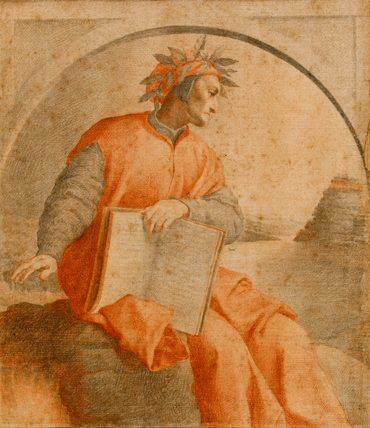
Dante Alighieri was much admired by the Félibres, such as Mistral, Estieu Prosper and Jules Azéma.
The Great Italian poet Dante Alighieri, in “De Vulgari Eloquentia” (the vulgar languages) divided the romance languages on the basis of the way each language says the simple word “Yes”. So we have the “Langue d’Oïl” (French), the “Langue d’Oc” (Provencal) and the “Lingua del Sì” (Italian). Starting from the XI century vulgar literature flourished in France with Chansons de Geste in the north (Langue d’Oïl) and the Troubadours (Langue d’Oc) in the South. In Italy, the vulgar literature started much later with the “Canticus or Laudes Creaturarum” (circa 1226) by S. Francis from Assisi whose mother was, not surprisingly, Occitan.
Brilliant!
More about Luigi
It can be frustrating when you have a burning desire to know and understand the Occitan culture but the existing manuscripts are difficult to translate; thus we must first express most grateful thanks to my friend Luigi Oliviero.
Luigi lives near Naples and is a Philologist, having studied Romance Philology, Latin Philology, Italian Philology, German Philology, Latin Literature, Latin paleography, Latin Language, Medieval history etc at the University of Cassino, Italy. He has a great love of his work with manuscripts.
I have sometimes worked with important manuscripts but two of them remain forever in my mind. The first one was in Biblioteca Nazionale in Rome, a manuscript recently acquired by the library. I was with my paleography classmates and my professor said to us "have a look at the manuscript and tell me something." The manuscript was well written but what attracted me were some notes on the edges. I recognized the handwriting of Francesco Petrarca (1304-1374) The best Italian Poet second to Dante Alighieri only. It was a book that he studied and he had held in his hands, as I now did; I was so very moved.
The second one was when I was able to browse the provençal manuscript D (Modena, Biblioteca Estense e Universitaria, α.R.4.4), the most important songbook in the tradition of the lyric of the troubadours written probably in 1254. I went there with a friend to see an exhibition of medieval maps of the world, they were so strange to their eyes as they had Jersualem in the center, so I started to explain something to my friends. An employee there that was following us with interest. So I dared to ask her if I could see the chansonnier provençal. It is so precious that I never suspected they could let me browse it. But they did!
I said "ciao !" (goodbye) to my friends and stayed in the library until closing time, without even having my lunch.
So Luigi makes an excellent translator of Languedocian documents from medieval times up to the present day. He also does impeccable Internet research and shares his findings with us. It all began when I purchased a book by Déodat Roché called "L'Eglise Romaine et les Cathares Albigeois" which means, The Roman Church and the Albigensian Cathars. In the book was the following illustration;
I posted it on Facebook, liking the style of it, then people asked for it to be translated, and Luigi came to the rescue like a medieval knight. It was the first page of the Cathar Ritual for prayers and other rituals including the Consolamentum. Luigi translated the first words. “Bless and spare us, amen. Be done of us according your word. May the Father and Son and Holy Ghost spare you all your sins. Let’s adore the Father and the Son and the Holy Ghost.”
Luigi continued; the copyist is not Italian: he is French. In fact he writes “espiritus” (esprit) instead of Spiritus, and also adhoremus and santus instead of adoremus and sanctus. The text in two columns, the large number of abbreviations, the style of the writing, make me think that this text is very late. My opinion? Post 1350 AD.
I said; "That's amazing! But how can it be 1350, when the Cathars were wiped out before that? I read somewhere that the consolamentum was actually very simple, and little more than the Lord's Prayer. I'm a bit concerned about the 'Father, Son and Holy Ghost.' I thought the Cathars didn't believe in the Trinity? If they did, what were they persecuted for?" Luigi replied; "The date is for the document as it appears in my eyes. You can have a prayer of the 4th century but copied much later by a copyist of the 13th century. I knew that the Trinity was a problem but that's what is written."
And so the conclusion was; it was a copy made in Italy from an Occitan manuscript. Many Cathars went to Spain, but also to northern Italy, to escape France.
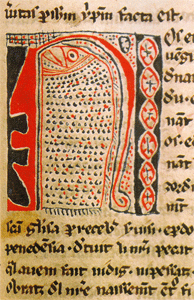 An illustration from the manuscript, known as the "Lyon Ritual."
An illustration from the manuscript, known as the "Lyon Ritual."
You can read more about the Lyon Ritual by clicking here.
You can read about the confession of sins (in English) here. "We have come before God . . . "
And for the use of the Lord's Prayer in the forgiveness of sins, quite a long ritual, in English, then click here.
To find out more about what the Consolamentum is, then click here.
Against the Cathars
I chose this image of a manuscript to act as a background image of some of the pages in "The Mayor That Was Me". All I knew was that it described the siege at Albi; but it was not from the point of view of the Cathars, I found out when Luigi translated.
This song, he tells us, was written in the style of the “Chanson of Antioch” which has “Alexandrine” lines of 12 syllables. The Antioch Song itself was composed about 1180 for a courtly French audience, then added to a cycle of epic poems inspired by the events of 1097 to 1099, when Antioch and Jerusalem were conquered.
This “Song of the Crusade” by Guilhèm de Tudèla described the Crusade against the “Albigensians” as the Cathars were sometimes called and was written in 1210.
Gentlemen, the song that you're going to hear is made
in the same manner of the one of Antioch, the metre and
the melody are the same if one is able to follow it.
You all have heard about the fact that the heresy
(may God damn it!) spread so wide that it conquered the whole Albigeois area
along with most parts of the Lauragais and Carcassès.
If one goes from Béziers to Bordeaux
there are many of their believers along with their supporters.
If I say even more I will not lie.
When the Pope and the rest of the Clergy
saw the multiplication of that madness,
that it made more than usual and that it grew from day to day,
they sent out preachers from their dominions
and the Cistercian Order that has jurisdiction
sent troops recruited among their members many times,
so that the bishop of Osma held court and council
and the other as legate with those from Bulgarie,
there in Carcassone where there were many people.
The king of Aragon himself was there, along with all his barons,
he left when he heard the subject
and when he had understood that they remained heretics.
He sent his letters to Rome in Italy.
I don’t know how to say it, may God bless me:
they don’t appreciate the sermons [more than] a rotten apple.
Five years, I don’t know how much, they behave this way,
those lost people did not want to convert themselves.
For this reason many men died, many people perished
and much more will die until the war will be over,
because it cannot be otherwise.
There was an abbey of the Cistercian order
that was near Lerida and that was named Poblet.
In this abbey there was a good man who was the abbot.
His wisdom was so high and growing day by day.
He was sent there from another abbey, Gran Selva
where he lived.
He was elected abbot and later on, afterwards
became abbot of Cîteaux for the great love God had for him.
This very blessed man went along with others
in the lands of heretics to preach them
to convert themselves. The more he preached to them
the more they flouted him and considered him a fool.
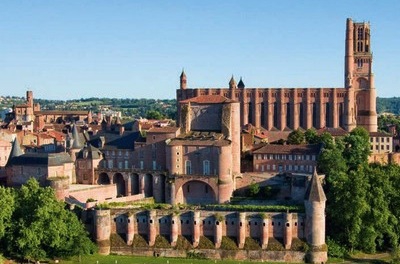 Albi and its cathedral as it is today, originally built as a fortress.
Albi and its cathedral as it is today, originally built as a fortress.
You can see much more about this manuscript in a book I later discovered! Click here.
More research
One day I received an image of a manuscript claiming to be by Josephus, the Roman historian who was in Judea at the time of Jesus. But the manuscript seem to be medieval to me, maybe written in Occitan, and so I asked Luigi’s help, saying; “The text is supposed to be what Josephus is saying about Jesus. But the style and design of this is medieval.”
He replied; “It seems the author is making a summary of Genesis chapter 1, so, I don't think it speaks about Jesus at all.” Indeed, the picture showed Adam and Eve.
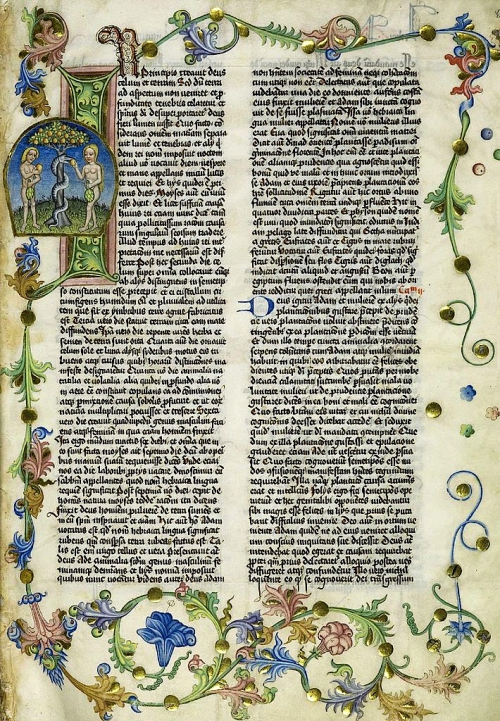
I explained that it was labelled as Josephus before it got to me, so maybe there was a mistake. “It is a good thing we have you as our resident Manuscript expert,” I added.
Luigi said; “But it could be Josephus. The Antiquitates Iudaicae makes a summary of the history of the Hebrews. In the first chapter of the Antiquitates Iudaicae he writes about the origins, so he starts with Genesis.”
“Then it must have been copied in medieval times?”
“Every surviving text was copied in medieval times.” (In my naiviety, I hadn’t realised this!) “This one is not early, it is a very "rich" manuscript so, I think it is a famous one. It is surely post 1300.”
Then Luigi did some research and added; “As I suspected the manuscript is famous, dated late, 1466, and it is in Poland. I can confirm it is XV century.” Then he sent a link so that I could see the book itself directly in the library in Poland.
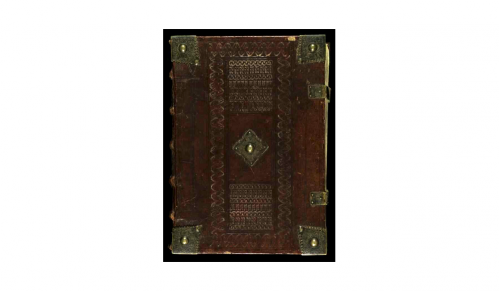
The cover of this book, the oldest version of Josephus's writings, isn’t it beautiful?
Luigi added; “Flavius Josephus wrote in Greek and your picture with Adam and Eve is a Latin translation. The oldest Greek manuscript is in Milan, Italy in the Biblioteca Ambrosiana.”
He sent me information on the four books that Josephus wrote and confirmed the Adam and Eve manuscript was part of the “Antiquities of the Jews.” Then he posted a link to all the manuscripts of Josephus. (The books are; I, Bellum Judaicum, 2, Antiquitates Judaicae 1-10 3, Antiquitates Judaicae 11-20, Vita and 4, Contra Apionem.)
My picture, explained Luigi, was a leaf from the "Judean antiquities," in which Josephus started by describing the Jews own history, but “goes on to the so called Testimonium Flavianum, that is to say a reference to the life of Jesus (and so a proof of his real existence) the reference in in Antiquitate Judaicae book XVIII, chapter 3,3 - I think this will really help, have a nice day.”
I looked up the link he sent and there was the original picture, captioned “A page from a 1466 copy of the Antiquities of the Jews!” So it wasn’t false at all! Here’s the link. It confirms that Josephus is one of our best sources for confirming passages in the Bible. It confirms, for example, that James who became the head of the Jerusalem church was indeed Jesus’s brother. However, as Luigi pointed out, some scholars say Josephus's account was edited later by Christians to give more credibility to the existence of Jesus. We will never know for sure unless an earlier manuscript is discovered.
Nothing to do with Occitan things at all; but I thought you would like the story of our research into old manuscripts.
Inscrivez-vous au blog
Soyez prévenu par email des prochaines mises à jour
Rejoignez les 28 autres membres


